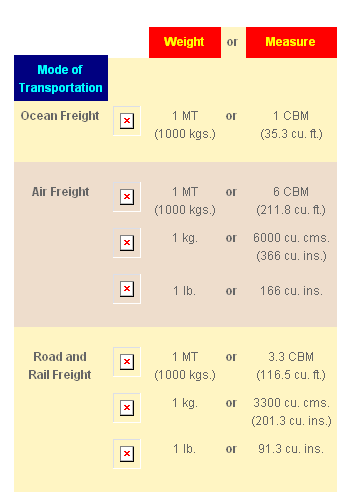
The freight rate on export goods is often based on W/M (weight or measure), that is, based on the weight or the volume of cargo (the cube or measurement of cargo). The rate uses the comparative relation between weight and volume of cargo. A cargo that is large in relation to its weight is charged according to its total cube, while a cargo that is heavy in relation to its size is charged according to its gross weight.
In general, light cargo is charged based on measure, while heavy cargo based on weight. Most sea consignments are charged based on measure, while most air consignments are charged based on weight.
The freight cost by weight or measure that will give the carrier the higher revenue is the rate that applies.
The unit of ton being used in the freight cost calculation may differ among carriers. It can be a metric ton (2204.6 lbs. or 1000 kgs.), a short ton (2000 lbs. or 907 kgs.), or a long ton (2240 lbs. or 1016 kgs.). The exporter must verify with the carrier which unit is being used. In practice, the most frequently used is the metric ton.
Units of Weight or Measure Commonly Used
in the Freight Cost Calculation
|
LEGEND: |
|
MT |
= metric ton |
|
kg. |
= kilogram |
|
lb. |
= pound |
|
|
CBM |
= cubic meter |
|
|
cu. cms. |
= cubic centimeters |
|
|
cu. ft. |
= cubic feet |
|
|
cu. ins. |
= cubic inches |
|

Some freight carriers may use the (long ton) 2240 lbs. (as weight) or 40 cu. ft. (as measure) in the freight cost calculation.
In ocean freight, some freight carriers may use the terms U.S. shipping ton and British shipping ton. One (1) U.S. shipping ton is equivalent to 40 cubic feet, and one (1) British shipping ton is equivalent to 42 cubic feet.
Other units may be used in the inland freight cost calculation. For example, the inland freight could be charged on a per package basis, but within a maximum allowable weight and/or cube per package. Some carriers may rate a product on a weight basis only.
In the case of irregular shaped cargo, the weight or measure applies, where the measure is determined by taking the three widest dimensions that describe the smallest cubic space enclosing the cargo.
|